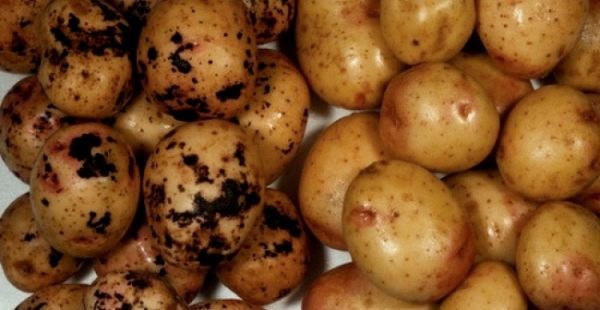
Potato scab, or as it is called in the scientific fields, rhizoctonia is a very common disease that can be found everywhere in almost every potato crop (photo of the affected culture can be seen below). This disease has the most negative effect on the planting material of this vegetable. You need to know the description of the disease, how to deal with it. Timely treatment can save the harvest.
Potato scab (rhizoctonia) can settle not only in the roots, but also on the stem of the plant. Exposure to this disease is found in the youngest crops, so they must be protected especially carefully. You should know the description of the disease and how to deal with it. Unformed potatoes can quickly become worthless and die from exposure to scab (photo below). In addition, rhizoctonia can rapidly move from one crop to another, which can lead to the loss of most of the future crop, therefore, timely treatment is required.
Content
Causes of scab on potatoes
The whole process of the spread and occurrence of such diseases is the active activity of spores, which primarily affect the tubers of the plant. Such factors are facilitated by external factors, such as the temperature regime in which the potato is contained, as well as increased humidity. The condition of the soil and its structure can also affect this. As it turned out, the reproduction of parasitic bacteria on loamy soils is much faster and their activity increases markedly.
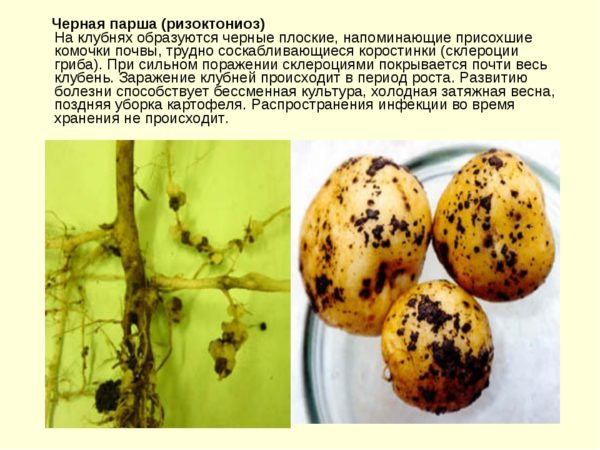
There is also a problem with regard to soil acidity, since it is the level that is most favorable for planting potatoes that coincides with the one in which the reproduction of bacteria occurs with the highest activity. In fact, the spread of scab on potatoes occurs because the environment in which the vegetable grows is the most favorable for bacteria.
How to learn about the appearance of scab on potatoes
The most common signs of scab on potatoes are dark spots, in-depth, as well as net necrosis. If the roots of your potato gradually rot, and the leaves of the plant show signs of dying, then this is a sure sign that your crop is at risk. There is a type of rhizoctoniosis called black scab. It got its name because of the dark spots that spread along the surface of the tubers of the plant.
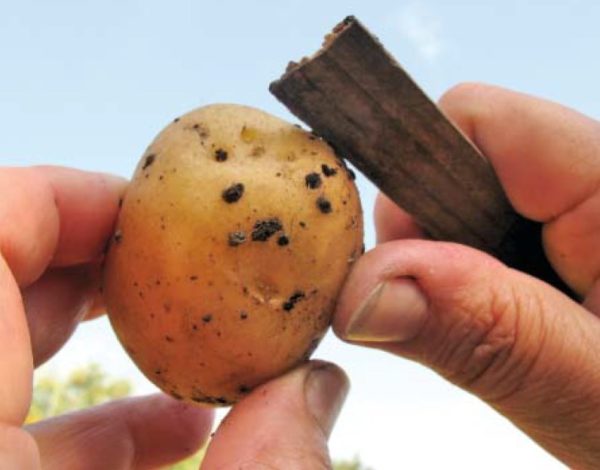
As a rule, this disease does not bring significant harm, since this species is passive. The main problem is that the scab can penetrate into the plant, starting the decomposition processes from the inside. Dark specks begin to form rings, and the color of the vegetable itself turns into a brown color. Then comes the turn of necrosis, after which the plant begins to gradually die.
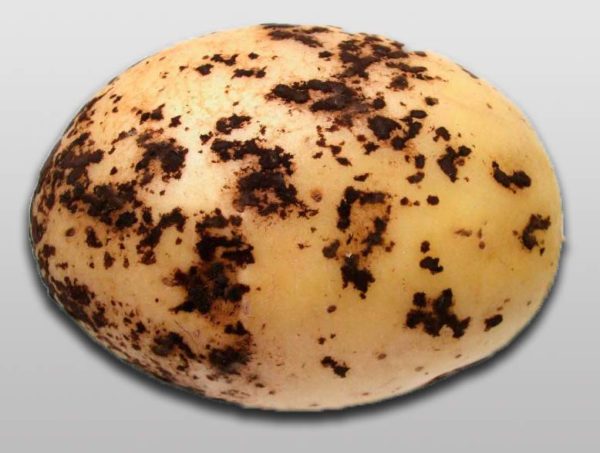
Signs of development of scab on potatoes
The progression of the development of harmful bacteria on potatoes is accompanied by several phases:
- Sleep phase. This is such a condition of rhizoctonia, which is in the form of sclerotia. Visually, you can easily detect them, since sclerotia looks like the very black spots that appear on the affected potato. It was because of the visual perception that such spots were called the “black scab”. Keep in mind that if you defeat potatoes at this stage, you should never plant this material, since it can infect neighboring root tubers.
- The phase of growth and parasitism. At this stage, sclerotia grows very quickly and forms mycelium, which rapidly ring the potato tuber, which negatively affects it, since planting material simply does not germinate. Decay occurs in the zone of inaccessibility of the human gaze, that is, still underground. Nevertheless, there are times when a potato can sprout, but its processes will still be infected. And this, in turn, can significantly affect the further development of the vegetable itself, as well as neighboring tubers.
- Breeding phase. It begins with the development of the so-called “white leg”. It represents the reproduction and spread of fungal spores, which can develop only in a favorable environment, namely in the presence of high humidity and air temperature of 20 degrees Celsius. It is at this stage of development that we can state the fact that the plant is completely infected and it must be urgently eliminated before the harmful bacteria have transferred to the neighboring potato.
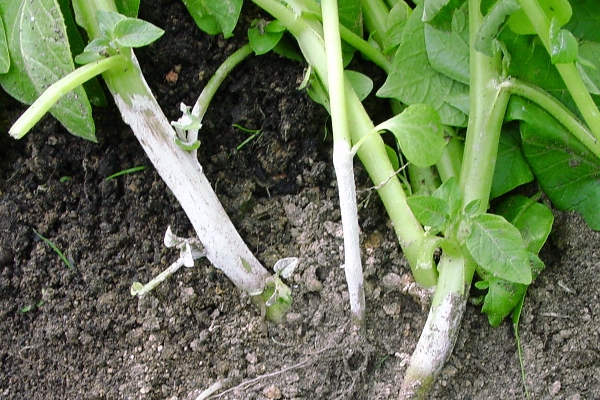
Types of black scab
According to experts, there are several subspecies of black scab:
- Common scab. The most favorable for the reproduction of black scab are dry soils, characterized by high acidity. Bacteria also feel good in dry soil, as well as in an environment that favors an alkaline reaction. The most optimal temperature for breeding common scab is 25-30 degrees. At the same time, pathogens can be located not only on potato tubers, but also in the earth itself and the organic residues in them. This type of scab can be recognized by irregular forms of ulcers that appear on root crops. If you click on them, they will turn out to be unnaturally hard. At the advanced stage, potato roots can be completely covered with these ulcers.
- Powdery scab. The causative agent in this case acts as a mucous lump, which can independently change its location. This species affects not only the roots, but also the stem of the plant. When a powdery scab is damaged, the rhizomes dry out quickly, however, if the planting material was stored in a place with an excess of moisture in the air, the tubers quickly begin to rot. When infected with this type of scab, the potato begins to become covered with convex outgrowths of a brown hue. If the soil is moistened too much, then this creates favorable conditions for the development of powdery scab.
- The scab is tuberous. This type of rhizoctonia is infected mainly by the roots of the plant. The shape and appearance of the affected areas depends on the variety of growing potatoes, as well as on the nature of the course of the disease.As a result of this, potatoes begin to lose their palatability; a decrease in starch and protein composition occurs in it. As a reason, poor seed quality or the improper use of agricultural technology in the cultivation of potatoes are usually distinguished.
- The scab is silver. It got its name due to the outward resemblance to a silver tint. Usually appears in the presence of high humidity, after which it begins to actively move to healthy tubers. The paradox of the effect of this type of scab is that the tubers begin to intensively lose moisture, but rot processes do not occur.
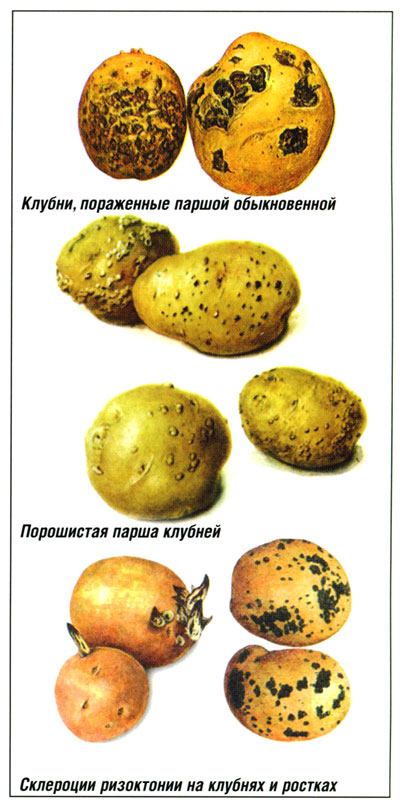
Prevention Methods
How to deal with scab of potatoes? This question worries not only novice gardeners, but also those who have been cultivating this vegetable for quite a long time. It is much easier to prevent the onset of the disease in advance than to subsequently deal with it.
First of all, the prevention and treatment of potatoes is necessary. It is very important to periodically sort out planting material in order to monitor whether there are signs of disease on it. If you notice at least one hint that rhizoctonia is present on one of the roots, you must immediately remove this planting material from the other.
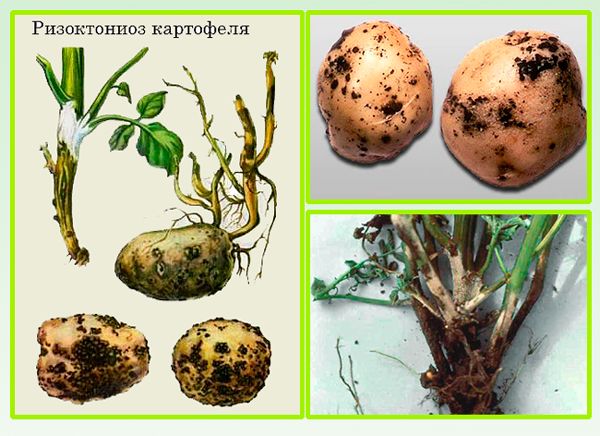
Also do not forget about agricultural technology. You must comply with the crop rotation system. If scab was previously found on potatoes, then most likely some of the bacteria remained in the soil. Potatoes should not be planted on this land earlier than 4 years later. It is very important to use seed of good quality, as well as resistant varieties of potatoes.
Preparations against rhizoctonia
There are many such drugs. The most effective are:
- Fitosporin. A very effective remedy against the development of fungal diseases in vegetables. The action is almost instant, immediately after use. Its effect is systemic, that is, the agent spreads throughout the plant.
- Mancozeb. It is a wettable powder. The product adheres to the surface of the plant, thereby creating a protective film that prevents the scab from spreading.
- Fenoram is super. It affects exclusively root crops. When used, there is a guarantee that the effect will remain until the end of the vegetative period.
- Colfugo. This tool is used to treat the plant during the growing season. It is mainly aimed at combating rhizoctonia in seed potatoes. It continues to operate, even if there will be heavy rains, since this does not affect the effect of use.
Reviews
According to many gardeners, the effectiveness of drugs has been proven in practice. Often, if gardeners try at least one of them, then subsequently apply it everywhere. Some even expressed regret that they had not used them before, but used mainly alternative methods of treatment and prevention.




 Description and description of varieties in Belarus with a photo
Description and description of varieties in Belarus with a photo Do I need to pick flowers from potatoes: why do they do it
Do I need to pick flowers from potatoes: why do they do it When to dig potatoes: timing and availability of new potatoes
When to dig potatoes: timing and availability of new potatoes How to grow a good potato crop: various methods and methods, planting and care
How to grow a good potato crop: various methods and methods, planting and care